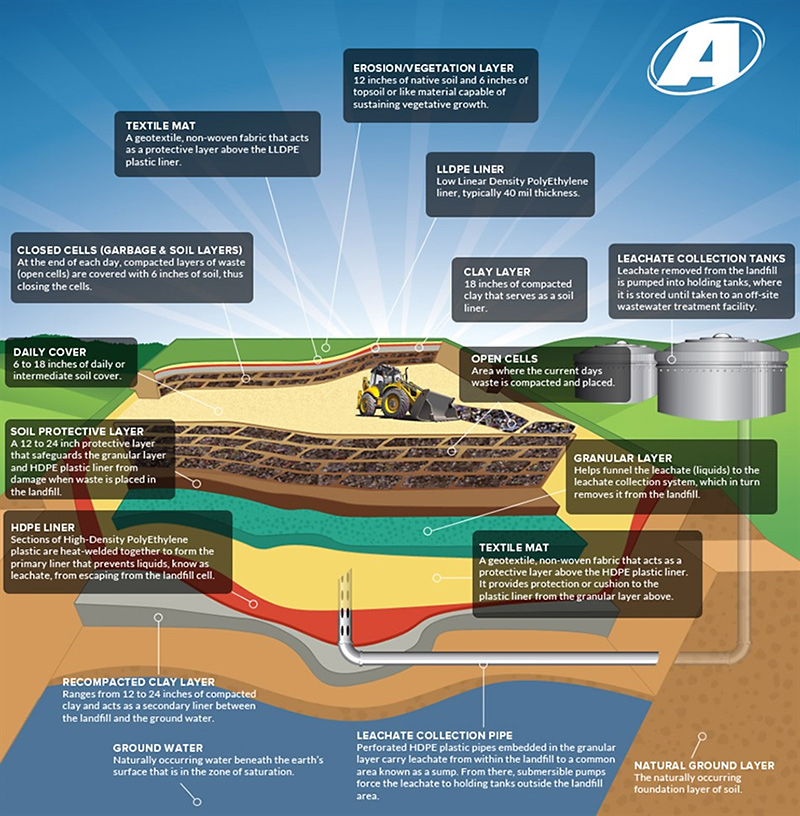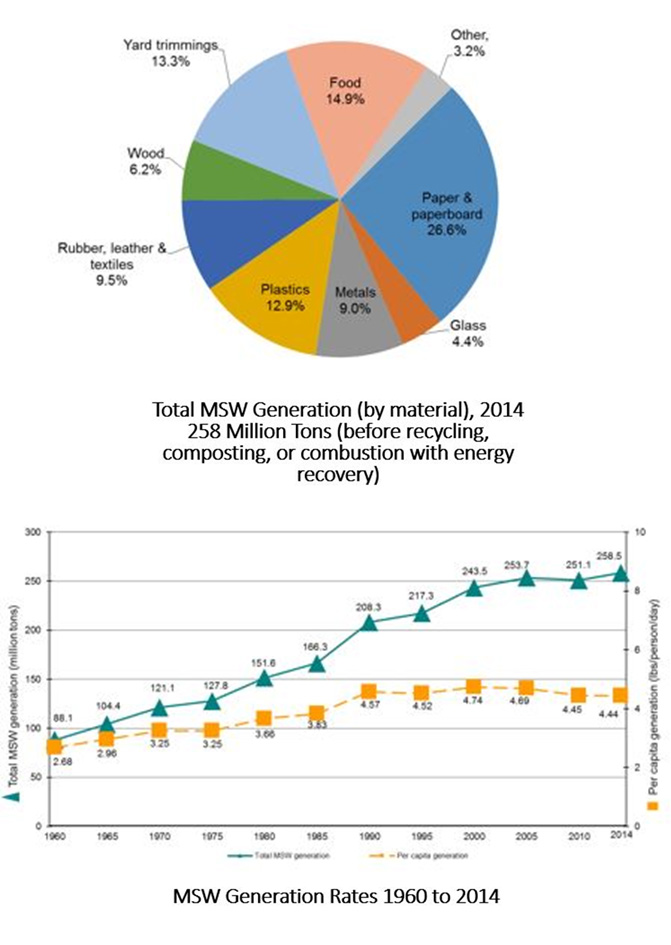
It may surprise you to know that the garbage that leaves your house will be preserved for centuries—in a landfill. More than a dump, landfills are an engineered storage system.
On the bottom, there’s a thick plastic membrane and a layer of compacted clay, to keep liquids from entering the groundwater.
Above that, the fill area is divided into cells for each day’s garbage. As trucks dump garbage into the cell, it’s compacted to become as small as possible.
At the end of the day, the cell is closed off with a layer of soil, and perhaps another layer of plastic, making it water- and airtight.
Most garbage won’t break down in this environment, though anaerobic bacteria will digest food and organic waste and produce methane, also known as natural gas, the same kind you burn in your stove.
Because it’s flammable, the methane has to be flared off. Or it can be collected and sold for industrial use. Or used to run electric generators at the landfill.
America leads the world, by a wide margin, in garbage production, with more than 1400 lbs per person per year. More than half of it ends up in landfills.
And 65 percent of that is packaging: cardboard, paper, plastic, bottles, and cans—nearly all of which could have been recycled.
On average, recycling costs about half as much as storing garbage in a landfill. So if you’d like to reduce your garbage footprint and your city’s municipal waste cost, recycling is the way to go.
Background
Synopsis: Management of waste has always been an issue in population centers. From the time of the Mayan Empire, burial or incineration in dumps at the outskirts of town was a common solution—until the town outgrew them. As populations and industry expanded, even more waste had to be managed. Engineers realized that a better solution was needed—engineered landfills.

Modified from Learn About Landfills, from the Advanced Disposal website.
- Modern landfills are not the same as what we used to, years ago, call “dumps.”
- A dump is an open hole in the ground where trash is buried and where animals often swarm. Dumps offer no environmental protection and are not regulated.
- A landfill is a carefully designed and monitored structure that isolates trash from the surrounding environment (e.g., groundwater, air, rain) with a bottom liner and daily covering of soil.
- Landfills contain garbage and serve to prevent contamination between the waste and the surrounding environment, especially groundwater.
- Landfills are designed not to break down trash but rather to bury it. They contain minimal amounts of oxygen and moisture, which prevent trash from breaking down rapidly.
- Landfills are carefully filled, monitored, and maintained while they are active and for up to 30 years after they are closed.
- The following are three main types of landfills:
- Municipal solid waste (MSW) landfill—A highly engineered, state-permitted disposal facility where municipal solid waste (nonhazardous waste generated from single family and multifamily residences, hotels, and the like, including commercial and industrial waste) may be disposed of for long-term care and monitoring. All modern MSW landfills must meet or exceed federal Subtitle D regulations to ensure environmentally safe and secure disposal facilities.
- Construction and demolition landfill—Construction and demolition (C&D) debris are materials produced in the process of construction, renovation, and/or demolition of structures, typically concrete, asphalt, wood, gypsum wallboard, paper, glass, rubble, and roofing materials. Some state definitions also include land-clearing debris (see next bullet) such as stumps, rocks, and dirt. C&D debris landfills are classified as nonhazardous and are regulated by state and local governments.
- Inert landfill—Inert material consists of earth and earthlike products, concrete, cured asphalt, rock, bricks, yard trimmings, and land-clearing debris such as stumps, limbs, and leaves.
- The main components of any secured, permitted municipal solid-waste landfill include the following:
- Bottom liner
- The bottom liner separates and prevents the buried waste from coming in contact with underlying natural soils and groundwater.
- In MSW landfills, bottom liners are generally constructed using some type of durable, puncture-resistant, synthetic plastic, high-density polyethylene (HDPE) ranging from 30 to 100 mil thick.
- The plastic liners may also be designed with a combination of compacted clay soils and synthetic plastic.
- Cells (old and new)
- This is the area in a landfill that has been constructed and approved for disposal of waste.
- Cells range in size (depending upon total tons of waste received each day at the landfill) from a few acres to as large as 20+ acres.
- Inside larger cells are smaller cells known as the daily workface, where waste coming into the landfill for disposal that day is prepared by placing the material in layers, or lifts, where it is then compacted and shredded by heavy landfill-compaction machinery.
- Leachate-collection system
- The bottom of each landfill is typically designed so that the bottom surface is sloped to a low point called a sump, where any liquids trapped inside the landfill—known in the waste industry as leachate—are collected and removed from the landfill.
- The leachate-collection system typically consists of a series of perforated pipes, gravel packs, and a layer of sand or gravel placed at the bottom of the landfill.
- Once the leachate is removed from the sump, it is typically pumped or gravity-flowed to a holding tank or pond, where it is either treated onsite or hauled offsite to a public or private wastewater-treatment facility.
- Storm-water drainage
- This is an engineered system designed to control water runoff during rain or storm events by directing the runoff through a series of berms, or ditches, to holding areas called sed (sediment) ponds.
- In sed ponds, runoff water flow is slowed down or held long enough to allow the suspended soil particles to settle out before the water is discharged offsite.
- Cover (or cap)
- Covering (or capping) is performed to isolate waste from exposure to the air and pests (such as birds, rats, and mice), and to control odors.
- Waste placed in a cell is required to be covered daily with either 6 inches of compacted soil or an alternative daily cover like spray-on flame- retardant fiber or tarpaulin material laid over the waste at the end of each day and removed the next day before additional waste is added.
- Other areas within the cells that are not completely filled and will not receive placement of additional waste may require additional cover known as intermediate cover—generally 12 to 18 inches of soil.
- When a section of the landfill is finished or filled to capacity, it is permanently covered with a combination of a layer of polyethylene plastic, compacted soil, and a layer of topsoil that will support growth of vegetation to prevent erosion.
- Groundwater monitoring stations
- These stations are set up to directly access and test the groundwater around the landfill for presence of leachate chemicals.
- Typically, a groundwater monitoring system will include a series of wells located upgradient of the landfill disposal area and a series of wells downgradient.
- To get a background analysis of the water, upgradient wells test water quality before it moves under the disposal area. Downgradient wells then allow testing of water after it has passed under the disposal area so it can be compared to the quality of the upgradient wells to make sure of no groundwater impact or contamination.
- Methane collection system
- Bacteria in the landfill break down trash in the absence of oxygen. This process produces landfill gas, which is approximately 50 percent methane.
- Since methane gas has the potential to burn or explode, it has to be removed from the landfill via a series of pipes embedded within the landfill to collect the methane gas.
- The gas, once collected, can be either naturally vented, control-burned, or converted to energy.
- Mature landfills have the most success with converting landfill gas to energy. There are three basic types of landfill gas-to-energy facilities:
- Electric—Landfill gas is used as a fuel to generate electricity at small power plants at the landfill or at a nearby industry, with the generated electricity delivered to a utility company.
- Alternative fuel—Landfill gas is piped to an industrial or commercial facility, where it is used for heating in place of, or in combination with, fossil fuels such as oil, coal, or natural gas.
- Processed gas—Landfill gas is processed and cleaned to natural-gas quality and delivered to transmission pipelines, to be used in normal applications for natural gas.
- Bottom liner
- U.S. residents—5 percent of the world’s population—produce 40 percent of the world’s waste, some of which is shipped to other countries for recycling and disposal.
- That’s more than 1600 lb of waste per American per year.
- Americans discard more than 16 billion diapers each year.
- The U.S. commercial air fleet could be rebuilt four times using only the aluminum disposed of in the country in a single year.
- Packaging material represents about 65 percent of household trash. About one-third of an average landfill consists of packaging material that probably could have been recycled.
- A ton of trash can be recycled for about $30, placed in a landfill for about $50, and incinerated for $65–$75.
- Whenever possible, try to “Reduce–Reuse–Recycle.”

